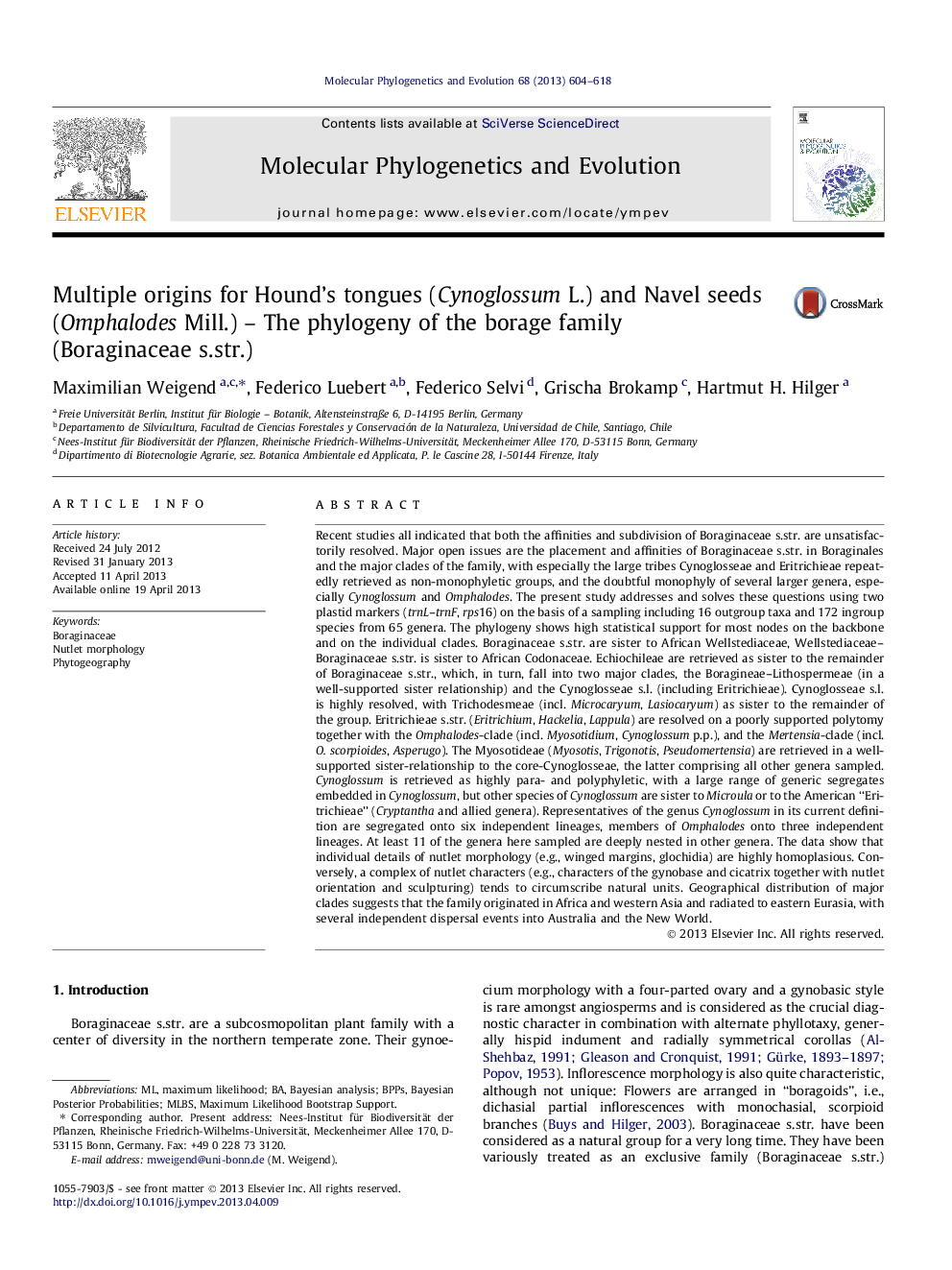| کد مقاله | کد نشریه | سال انتشار | مقاله انگلیسی | نسخه تمام متن |
|---|---|---|---|---|
| 5919802 | 1164272 | 2013 | 15 صفحه PDF | دانلود رایگان |

- Phylogeny and affinities of the family Boraginaceae are resolved for the first time.
- Boraginaceae is most closely allied to the African Wellstediaceae and Codonaceae.
- Traditionally established genus and tribe limits are shown to be largely unnatural.
- Similar derivations in fruit morphology have arisen repeatedly and independently.
- The genera Cynoglossum (Hound's tongue) and Omphalodes (Navel-seed) are shown to be highly poly- and paraphyletic.
Recent studies all indicated that both the affinities and subdivision of Boraginaceae s.str. are unsatisfactorily resolved. Major open issues are the placement and affinities of Boraginaceae s.str. in Boraginales and the major clades of the family, with especially the large tribes Cynoglosseae and Eritrichieae repeatedly retrieved as non-monophyletic groups, and the doubtful monophyly of several larger genera, especially Cynoglossum and Omphalodes. The present study addresses and solves these questions using two plastid markers (trnL-trnF, rps16) on the basis of a sampling including 16 outgroup taxa and 172 ingroup species from 65 genera. The phylogeny shows high statistical support for most nodes on the backbone and on the individual clades. Boraginaceae s.str. are sister to African Wellstediaceae, Wellstediaceae-Boraginaceae s.str. is sister to African Codonaceae. Echiochileae are retrieved as sister to the remainder of Boraginaceae s.str., which, in turn, fall into two major clades, the Boragineae-Lithospermeae (in a well-supported sister relationship) and the Cynoglosseae s.l. (including Eritrichieae). Cynoglosseae s.l. is highly resolved, with Trichodesmeae (incl. Microcaryum, Lasiocaryum) as sister to the remainder of the group. Eritrichieae s.str. (Eritrichium, Hackelia, Lappula) are resolved on a poorly supported polytomy together with the Omphalodes-clade (incl. Myosotidium, Cynoglossum p.p.), and the Mertensia-clade (incl. O. scorpioides, Asperugo). The Myosotideae (Myosotis, Trigonotis, Pseudomertensia) are retrieved in a well-supported sister-relationship to the core-Cynoglosseae, the latter comprising all other genera sampled. Cynoglossum is retrieved as highly para- and polyphyletic, with a large range of generic segregates embedded in Cynoglossum, but other species of Cynoglossum are sister to Microula or to the American “Eritrichieae” (Cryptantha and allied genera). Representatives of the genus Cynoglossum in its current definition are segregated onto six independent lineages, members of Omphalodes onto three independent lineages. At least 11 of the genera here sampled are deeply nested in other genera. The data show that individual details of nutlet morphology (e.g., winged margins, glochidia) are highly homoplasious. Conversely, a complex of nutlet characters (e.g., characters of the gynobase and cicatrix together with nutlet orientation and sculpturing) tends to circumscribe natural units. Geographical distribution of major clades suggests that the family originated in Africa and western Asia and radiated to eastern Eurasia, with several independent dispersal events into Australia and the New World.
Journal: Molecular Phylogenetics and Evolution - Volume 68, Issue 3, September 2013, Pages 604-618